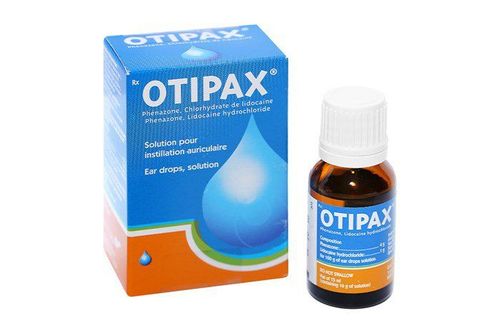This is an automatically translated article.
Augmex is a betalactam antibiotic used orally in cases of infections caused by susceptible bacteria. To better understand the use of Augmex antibiotic, please refer to the information through the article below.
1. What are the effects of Augmex?
Augmex antibiotic has Amoxicillin 500mg and Clavulanic acid 125mg ingredients.
Amoxicillin is a semi-synthetic beta-lactam antibiotic, which inhibits one or more enzymes in the biosynthesis of peptidoglycan (substance required for cell wall stability) of bacteria, which is a component. structural importance in bacterial cell walls. Inhibition of peptidoglycan synthesis weakens the cell wall, resulting in bacterial cell lysis and death.
However, Amoxicillin is easily degraded by beta-lactamase enzymes produced by antibiotic-resistant bacteria and therefore the spectrum of action is narrow to exclude bacteria that produce these enzymes.
Clavulanic acid has a beta-lactam structure that closely resembles penicillin. It has a strong binding effect and causes inactivation of beta lactamase enzymes, thus preventing inactivation of Amoxicillin. Clavulanic acid alone has no clinically significant antibacterial activity.
The combination of these two active ingredients increases the effectiveness and broadens the spectrum of action of Amoxicillin.
2. Indications and contraindications of Augmex
Indications:
Augmex antibiotic is indicated in the following cases:
Acute bacterial rhinosinusitis. Acute otitis media .Antibiotics Acute exacerbation of chronic bronchitis; community pneumonia. Cystitis; nephritis - pyelonephritis. Skin and soft tissue infections such as cellulitis, boils, abscesses, post-animal bites, and severe dental abscesses cause diffuse cellulitis. Bone and joint infections, especially in osteomyelitis. Pharyngitis, tonsillitis. Obstetric and gynecological infections. Contraindications:
Augmex is contraindicated in the following cases:
Hypersensitivity to the active ingredients of the penicillin group or any of the excipients. History of serious immediate hypersensitivity (such as anaphylaxis) to other beta-lactam drugs (including cephalosporins, carbapenems or monobactams). History of jaundice due to impaired liver function caused by amoxicillin/clavulanic acid compounds.
3. How to use and dose Augmex
3.1. How to take Augmex Antibiotics Augmex are taken orally. The drug should be taken on an empty stomach to minimize the possibility of drug intolerance in the gastrointestinal tract. This medication should be taken at regular intervals to help maintain blood levels of the drug and increase its effectiveness.
The duration of treatment should be decided depending on the patient's response. Some infections (such as osteomyelitis) often require longer-term treatment. Treatment should not be prolonged beyond 14 days without re-evaluating the benefits and risks of this treatment.
3.2. Dosage of Augmex For Adults and Children > 40kg:
Dosage is 500mg/125mg taken 3 times a day. The total daily dose of Augmex antibiotic should not exceed 1500mg Amoxicillin/ 375mg clavulanic acid Children < 40kg:
Dose 20mg/5mg/kg/day to 60mg/15mg/kg/day usually divided into 3 times a day. The maximum daily dose of Augmex is 2400mg Amoxicillin/600mg clavulanic acid. Children under 25kg: Because the tablets cannot be broken down, children weighing less than 25kg should not take Augmex tablets. The suspension should be used.
Elderly: No dose adjustment is necessary.
Impaired Renal Function: Adjust dose according to the maximum recommended dose of Amoxicillin. No dose adjustment is required in patients with creatinine clearance (CrCl) greater than 30 ml/min.
Hepatic impairment: No dose adjustment is required, but close monitoring is required.
3.3. Overdose and missed dose Augmex
Overdose:
Symptoms of overdose are gastrointestinal symptoms and disturbances in water and electrolyte balance. Amoxicillin crystals have been observed, in some cases leading to renal failure. Convulsions may occur in patients with renal failure or in patients receiving high doses of the drug. Treatment: The patient should be taken to a medical facility as soon as possible. Treat gastrointestinal symptoms, pay attention to water and electrolyte balance. Augmex can be removed from the circulation by hemodialysis. Missed dose:
If you forget to take a dose, take it as soon as you remember. However, if it is almost time for your next dose, skip the missed dose and continue taking your next dose at the scheduled time. Avoid forgetting medication as this reduces the effectiveness of the antibiotic, increasing the risk of drug resistance.
4. Side effects of antibiotics Augmex
When using Augmex, you may experience unwanted effects, including:
Very common: Gastrointestinal disturbances such as diarrhea. Common: Mucosal candidiasis; nausea (nausea often occurs with higher doses. If gastrointestinal reactions occur, symptoms can be relieved by taking the drug with meals), vomiting. Uncommon: Headache, dizziness; undigested; increased AST and/or ALT; skin rash, pruritus, urticaria. Rare: Reversible cytopenia (including leukopenia), thrombocytopenia; erythema multiforme. Frequency unknown: proliferation of non-susceptible strains; Reversible agranulocytosis, hemolytic anemia, prolongation of bleeding time and prothrombin time; neurovascular edema, anaphylaxis, serum sickness-like syndrome, hypersensitivity vasculitis; reversible hyperactivity, convulsions, aseptic meningitis; Antibiotic-associated enteritis, black hairy tongue; hepatitis , cholestatic jaundice; Stevens-Johnson syndrome, acute generalized exanthematous pustulosis (AGEP), bullous exfoliative dermatitis, toxic epidermal necrolysis; interstitial nephritis, crystalluria. If you notice any of these or other side effects while taking this medicine, you should tell your doctor right away for advice.
5. Caution when using Augmex antibiotics
Before starting treatment with Amoxicillin/clavulanic acid, tell your doctor about any history of allergy to Penicillins, Cephalosporins or other beta-lactam drugs. There have been reports of serious and sometimes fatal hypersensitivity reactions in patients treated with penicillin. If an allergic reaction occurs, you should stop taking Amoxicillin/clavulanic acid and replace it with another antibiotic. In cases where it is certain that the organism is susceptible to Amoxicillin, the patient should be considered switching from Amoxicillin/clavulanic acid to amoxicillin alone as recommended by the sources. The drug may cause convulsions in patients with impaired renal function or in patients receiving high doses. The combination of Amoxicillin/clavulanic acid should be avoided if mononucleosis is suspected, due to the development of a measles-like rash associated with this condition with Amoxicillin. Long-term use of this or any other antibiotic can sometimes cause the proliferation of non-susceptible strains of bacteria. Pay attention to fungal or other non-susceptible bacterial infections. The appearance of a febrile systemic erythema with pustules at the start of treatment may be a sign of acute generalized exanthematous pustulosis (AGEP). If so, then Augmex should be discontinued and Amoxicillin contraindicated thereafter. Amoxicillin crystals in urine have been observed in patients with decreased urinary excretion, but very rarely, occurring mainly in patients receiving parenteral therapy. When high doses of Amoxicillin are administered, oral or infusion should be taken to maintain adequate fluid intake and urine output to reduce the likelihood of amoxicillin crystalluria. Amoxicillin/clavulanic acid should be used with caution in patients with evidence of hepatic impairment. There have been reports of liver damage occurring mainly in men and the elderly. Very rarely, adverse effects on the liver have been reported in children. Liver failure is reversible, liver damage can be severe, and death has been extremely rare. Enteritis associated with antibiotic use has been reported and ranges in severity from mild to life-threatening. Therefore, it is important to make a diagnosis in patients who develop diarrhea during or after treatment. If enteritis occurs, the use of Augmex should be discontinued immediately and a physician should be consulted to initiate appropriate therapy. Pregnancy: Animal studies have shown no direct or indirect harmful effects on pregnancy, parturition or postnatal development. Limited data on the use of Augmex during pregnancy in humans do not indicate a risk of birth defects. But in a number of studies in women who gave birth prematurely due to preterm rupture of membranes, it was reported that the use of Augmex for the prevention of bacterial infections may be associated with an increased risk of necrotizing enterocolitis in the neonate. Therefore, it is best to avoid taking the drug during pregnancy. Lactation: Both active ingredients in Augmex are secreted into breast milk, but the effect of clavulanic acid on breastfed infants is unknown. Amoxicillin/clavulanic acid should be used during breastfeeding only after weighing the benefits and risks of treatment.
6. Drug interactions
Some drugs may interact as follows:
Concomitant use of Allopurinol during treatment with Amoxicillin may increase the risk of an allergic skin reaction. Oral Anticoagulants: Oral anticoagulants and penicillin antibiotics are widely used in practice without reports of drug interactions. However, cases of increased INR have also been reported in patients treated with Acenocoumarol or Warfarin and required a course of Amoxicillin. If these two drugs must be co-administered, careful monitoring of prothrombin time or INR is required. In addition, it may also be necessary to adjust the dose of oral anticoagulants. Methotrexate: Penicillins can reduce the excretion of methotrexate thereby increasing the risk of drug toxicity. Probenecid: Co-administration of drugs with probenecid is not recommended. Probenecid reduces the renal tubular excretion of Amoxicillin. Concomitant use with Probenecid may increase and prolong blood levels of Amoxicillin but has no effect on Clavulanic acid. Storage: Store the drug in a tightly closed container, protected from light and moisture. At room temperature not exceeding 30 degrees C. Keep the medicine out of reach of children, do not use when expired and show signs of damage.
Augmex is a broad-spectrum antibiotic, should only be used as prescribed by a doctor when there is an infection to avoid the risk of drug resistance. If you have any unusual symptoms while taking this medicine, you should tell your doctor or pharmacist for advice.













